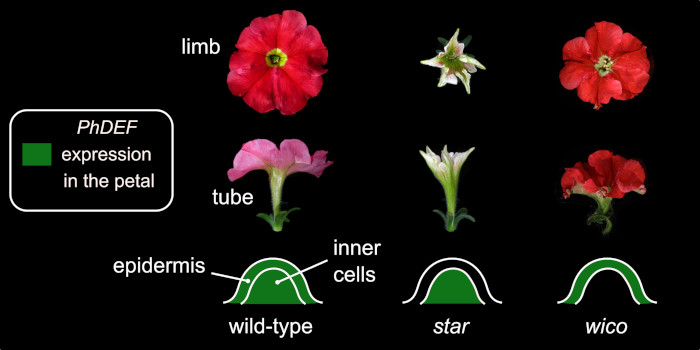From cell layers to complex petal shapes
Chopy et al. investigate the layer-specific contribution of the petunia homolog of DEFICIENS (PhDEF) in petal tube and limb development.
https://doi.org/10.1093/plcell/koad258
Background: Petals are not only beautiful, but they are also very important floral organs that have co-evolved with different animal visitors to ensure pollination. This long co-evolution produced many complex petal shapes. In the case of Petunia, the fused petals are organized in two domains, the tube and the limb; this influences the interaction of the flower with hawkmoths, hummingbirds, or bees. Petal identity genes, such as PhDEFICIENS (PhDEF), trigger petal development resulting in mature petals. However, the mechanisms by which those genes drive complex petal shape with tube and limb, are unclear.
Question: Petals are formed of cell layers: the epidermis and the internal cells. In a wild-type flower, the petal identity gene PhDEF is expressed in all cell layers. But what happens if PhDEF expression is restricted to a specific cell layer? In other words, we wanted to investigate the layer-specific contribution of PhDEF in petal tube and limb development.
Findings: By chance, we obtained the perfect material to address this question: Two categories of Petunia hybrida mutants (chimeras) expressing PhDEF exclusively in the petal epidermis or in the inner cells, called wico and star, respectively. The resulting flowers displayed dramatically different limb and tube shape (see picture): wico flowers form a strongly reduced tube while their limb is almost normal, and star flowers form a normal tube but a very reduced limb. This suggests that petunia petal morphogenesis is highly modular, and depends on the cell layer-specific expression of PhDEF.

Next steps: This study is a first step towards understanding the link between PhDEF and complex petal development. A major future challenge is to identify the genes acting downstream of the petal identity genes, at the tissue (epidermis vs internal cells) and organ (limb vs tube) scales.
Reference:
Chopy M., Cavallini-Speisser Q., Chambrier P., Morel P., Just J., Hugouvieux V., Rodrigues Bento S., Zubieta C., Michiel Vandenbussche and Marie Monniaux (2023) Cell layer-specific expression of the homeotic MADS-box transcription factor PhDEF contributes to modular petal morphogenesis in petunia. https://doi.org/10.1093/plcell/koad258



